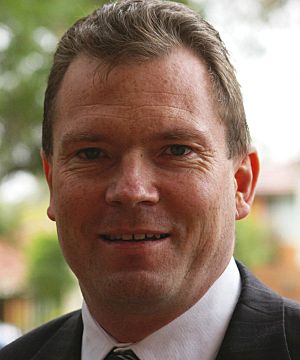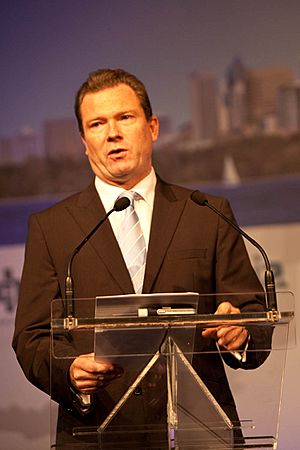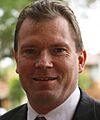Nathan Rees facts for kids
Quick facts for kids
Nathan Rees
|
|||||||||||||||||||||||||||||||||||||||||||||||||||||||
|---|---|---|---|---|---|---|---|---|---|---|---|---|---|---|---|---|---|---|---|---|---|---|---|---|---|---|---|---|---|---|---|---|---|---|---|---|---|---|---|---|---|---|---|---|---|---|---|---|---|---|---|---|---|---|---|
 |
|||||||||||||||||||||||||||||||||||||||||||||||||||||||
| 41st Premier of New South Wales | |||||||||||||||||||||||||||||||||||||||||||||||||||||||
| In office 5 September 2008 – 4 December 2009 |
|||||||||||||||||||||||||||||||||||||||||||||||||||||||
| Monarch | Elizabeth II | ||||||||||||||||||||||||||||||||||||||||||||||||||||||
| Governor | Marie Bashir | ||||||||||||||||||||||||||||||||||||||||||||||||||||||
| Deputy | Carmel Tebbutt | ||||||||||||||||||||||||||||||||||||||||||||||||||||||
| Preceded by | Morris Iemma | ||||||||||||||||||||||||||||||||||||||||||||||||||||||
| Succeeded by | Kristina Keneally | ||||||||||||||||||||||||||||||||||||||||||||||||||||||
| Member of the New South Wales Legislative Assembly for Toongabbie |
|||||||||||||||||||||||||||||||||||||||||||||||||||||||
| In office 24 March 2007 – 6 March 2015 |
|||||||||||||||||||||||||||||||||||||||||||||||||||||||
| Preceded by | District established | ||||||||||||||||||||||||||||||||||||||||||||||||||||||
| Succeeded by | District abolished | ||||||||||||||||||||||||||||||||||||||||||||||||||||||
|
|||||||||||||||||||||||||||||||||||||||||||||||||||||||
| Personal details | |||||||||||||||||||||||||||||||||||||||||||||||||||||||
| Born | 12 February 1968 Sydney, New South Wales, Australia |
||||||||||||||||||||||||||||||||||||||||||||||||||||||
| Political party | Labor Party | ||||||||||||||||||||||||||||||||||||||||||||||||||||||
| Spouse | Stacey Haines | ||||||||||||||||||||||||||||||||||||||||||||||||||||||
| Education | Northmead Creative and Performing Arts High School University of Sydney |
||||||||||||||||||||||||||||||||||||||||||||||||||||||
Nathan Rees (born 12 February 1968) is an Australian former politician. He served as the 41st Premier of New South Wales and leader of the New South Wales Labor Party. He held these roles from September 2008 to December 2009. Rees was also a Member of the New South Wales Legislative Assembly. He represented the area of Toongabbie for the Labor Party from 2007 to 2015.
Rees became Premier and party leader on 5 September 2008. He took over from Morris Iemma. At 40 years old, he was the youngest person to become Premier of New South Wales at that time. This record was later broken by Dominic Perrottet. On 3 December 2009, Rees was replaced as leader by Kristina Keneally. He lost a secret vote within the Labor Party after being Premier for fifteen months. He is the shortest-serving Premier in New South Wales since Australia became a federation. He is also the only Labor Premier of New South Wales who did not lead the party into an election.
Contents
Early Life and Education
Nathan Rees was born in 1968 in Western Sydney. His parents were Daryl and Frances. His mother was a long-time member of the Labor Party. He went to Northmead Creative and Performing Arts High School. There, he was the school captain.
After school, he first worked as a greenskeeper for Parramatta Council. He also studied English literature at the University of Sydney. He earned an honours degree in 1994. To support himself, he worked as a garbage collector for the same council. During his time at the council, he became Secretary of the Municipal and Shire Employees Union.
Rees was also a long-distance runner. He was a member of the Parramatta Cycling Club. He won many events and cycled up to 1,000 km per week when training. He once finished third in a state triathlon.
Starting a Political Career
Rees began his political career in 1995. He became an adviser to the deputy premier, Andrew Refshauge. His mother, Frances, also worked for Refshauge. During this time, Rees often cycled over 90 km between his home in the Blue Mountains and central Sydney.
He later worked for Ministers Craig Knowles and Morris Iemma. He also served as chief of staff for Minister Milton Orkopoulos. Rees moved to the Premier's office in 2006. He stated he had no knowledge of any wrongdoing by Orkopoulos. He said he would have reported him if he had known.
Becoming a Minister
Rees was elected to the New South Wales Legislative Assembly on 24 March 2007. He was quickly promoted to cabinet. On 2 April 2007, he became Minister for Emergency Services and Minister for Water Utilities.
As Minister for Water Utilities, Rees was in charge of big projects. These included the $1.9 billion Sydney Desalination Plant at Kurnell. He also oversaw the proposed Tillegra Dam in the Hunter Region.
When Rees became Water Utilities Minister, Sydney faced severe drought. Water had to be moved from the Shoalhaven River to Sydney. Water restrictions were also put in place. The controversial Sydney Desalination Plant was finished while Rees was Minister. This project came in under budget and had double its planned capacity. Contracts were also made to power the plant with renewable energy.
In July 2008, media suggested Rees might become Premier. Rees denied this, saying he fully supported Premier Iemma. Two months later, Morris Iemma was replaced by Rees.
Serving as Premier
Iemma resigned on 5 September 2008. His own party group did not support his plans to change the Cabinet. They then agreed to support Rees. Later that day, Rees was chosen as Labor leader and Premier. He was sworn in by Chief Justice of New South Wales James Spigelman. This happened after only nineteen months as a Member of Parliament. Carmel Tebbutt was chosen as Deputy Leader and Deputy Premier. On 8 September, Rees also became Minister for the Arts.
During the 2008 financial crisis, government income dropped. Rees and State Treasurer Eric Roozendaal had to create a mini-budget. This budget was announced on 11 November 2008. It increased taxes and charges. It also announced the sale of some state assets. Free public transport for students was reduced, though this decision was later changed. Large rail projects were also put on hold.
After his wedding in New York, Rees denied rumors of a leadership challenge. After some changes in his cabinet, Rees also became Minister for the Central Coast.
On 14 November 2009, Rees gained special powers from the Labor State Conference. He could choose his own cabinet. Usually, the party's members and head office choose the ministers. The next day, Rees removed some ministers and parliamentary secretaries. He said they were blocking reforms and trying to remove him. This was his fourth cabinet change as Premier.
Economy and Jobs
Rees became Premier on 5 September 2008. Eleven days later, Lehman Brothers collapsed during the 2008 financial crisis.
The Rees government responded with a three-point plan. First, they aimed to keep a Triple A credit rating. This was important for borrowing money at low rates. Second, Rees announced a mini-budget for November 2008. This budget delayed large projects. Instead, it focused on smaller projects that could create jobs faster. Third, Rees held a job summit with business leaders. He also announced 4,000 government apprenticeships and 2,000 cadetships.
After the 2009/10 Budget, NSW's AAA credit rating was confirmed. The outlook for NSW was upgraded from negative to stable. Rees later said NSW was the only place to improve its credit rating during the crisis. The 2009/10 Rees Budget had the largest spending on public works in the state's history, over $18 billion.
Education Changes
During his time as Premier, Rees and his Education Minister, Verity Firth, made big changes to NSW education. In January 2009, Rees announced that the minimum school leaving age would increase from 15 to 17 years.
With the Federal government, Rees also created 175,000 new training places. These were in vocational training. He also guaranteed training for apprentices whose studies were interrupted.
Rees also introduced non-religious Ethics classes into primary schools. This was a controversial move.
Law and Order Initiatives
Soon after becoming Premier, a gang-related incident at Sydney airport occurred. This led Rees to introduce laws to ban criminal gangs. These laws faced strong opposition. In June 2011, the High Court ruled against the government.
In the 2009/10 Budget, the NSW police force received $10 million. This was to equip police with Taser stun guns.
Rees also introduced measures to reduce violence linked to alcohol. These included mandatory lockouts for venues. They also included using plastic cups and naming violent venues. After these measures, incidents of 'glassings' dropped significantly.
Despite ongoing disputes between criminal groups, crime statistics showed improvements. Many major crime categories were stable or falling.
Protecting the Environment
Rees continued the work of previous leaders in protecting the environment. He announced the preservation of the last large area of River Red Gums in the state's south. This completed a forest preservation program.
Rees also announced the creation of Yengo National Park in June 2009. This park covers 120,000 hectares of bushland. The Rees government also added 65,000 hectares to Yanga National Park.
Improving Transport
Previous governments had been criticized for not spending enough on public transport. Due to the financial crisis, Rees focused on expanding the bus network. He believed this would improve transport faster than large rail projects. So, 450 new buses were ordered.
Rees also opened the Epping to Chatswood rail line. This was the first major rail project in ten years. Its usage quickly exceeded expectations.
In November 2009, Rees approved Stage 2 of the South West Rail Link. This $1.3 billion project aimed to improve rail services in south-western Sydney.
Train service reliability reached a ten-year high of 95% on-time running. Ferry services from the city to Parramatta were also restored. Free shuttle buses were introduced in Sydney and Wollongong city centers. To encourage weekend public transport use, the government introduced $2.50 Family Fun Day fares for Sundays. These fares also offered discounts to museums and tourist spots. A simpler fare structure for the rail network was also introduced.
Health System Improvements
Rees established the Bureau of Health Information in July 2009. This bureau produces regular reports on the NSW health system's performance. This includes waiting lists.
An Australian Government report in June 2009 stated that NSW had the best elective surgery and emergency department performance in Australia.
Rees also introduced eyesight screening for preschoolers. This complemented universal hearing tests that were already in place.
Aboriginal Affairs
In November 2009, Rees announced the largest return of Aboriginal land in the state's history. The Yuin people of the South Coast had claimed 20,000 hectares of land. This included parts of Morton National Park and Yerriyong State Forest. Rees granted the claim in full.
Supporting the Arts
As Arts Minister, one of Rees's first tasks was to announce an annual festival, Vivid Sydney. This was described as a 'festival of lights and ideas'. The first curator was Brian Eno, a famous music producer. Rees famously said, "I'd rather have Brian Eno for two weeks than Tiger Woods for 3 days."
While Minister for the Arts, Rees also gave independence to the National Art School. He also started planning for a new visual arts center in Parramatta. This commitment was continued by Kristina Keneally when she became Premier.
Rees also created the 'Parramasala' festival in Parramatta. He helped bring A.R. Rahman, famous for Slumdog Millionaire, to Sydney. Rahman performed a free open-air concert that attracted over 50,000 people.
Government Reform Efforts
After many years in government, there had been some scandals involving Labor ministers. Rees aimed to distance himself from these with various reforms. He updated the Freedom of Information Act. It was replaced with the Government Information (Public Access) Act. This new act aimed for more public release of government information. Rees also appointed an independent commissioner to oversee this act.
In November 2009, Rees announced he wanted public funding for election campaigns. This would reduce reliance on large company donations. He also banned donations from property developers to the NSW Labor Party.
Rees also made it a rule for lobbyists to be registered. They also had to follow a Lobbyist Code of Conduct.
Leaving the Premier Role
On 3 December 2009, Rees faced a vote to remove him as leader. The motion passed. In the vote for a new leader, Kristina Keneally defeated Rees. She won by 47 votes to 21. Earlier that day, Rees said that any challenger would be controlled by certain powerful figures. On 22 October 2010, Rees was allowed to keep the title "The Honourable". He was the first NSW Labor Premier not to lead the party into an election.
After being removed as Premier, Rees chose not to serve in the new Cabinet. He remained a Member of Parliament until the March 2011 election.
The Keneally government lost badly in the 2011 state election. Rees almost lost his own seat. He remained in parliament by only 205 votes. After the election, the new Opposition leader John Robertson appointed Rees as Shadow Minister for Police and Emergency Services and Shadow Minister for the Arts.
Independent Commission Against Corruption
In 2013, the Independent Commission Against Corruption (ICAC) held public hearings. These hearings looked into allegations of improper conduct by Ian Macdonald and Eddie Obeid. Both men had played a role in Rees being removed as Premier. The ICAC found that both Macdonald and Obeid had acted improperly. They recommended that criminal charges be considered against them. Rees stated he was distressed that the party had been linked to those investigated.
Retirement from Politics
On 28 March 2014, Rees announced he would retire from politics. He did not run in the next state election in 2015. This decision was likely influenced by changes to his electoral district. His old seat of Toongabbie was largely moved into a new area, Seven Hills. This new seat was expected to be won by the Liberal Party.
Life After Politics
In October 2014, after announcing his retirement, Rees became the chief executive of the Public Education Foundation (PEF). This non-profit group provides scholarships to students who need help. These scholarships support them to stay in school. Rees said, "The public education system in NSW is very strong but this foundation will allow those kids who may not have the resources to buy the extra book or the bit of software they need."
After leaving the PEF, Rees was appointed National Assistant Secretary of the Finance Sector Union (FSU) in May 2017. He worked there until early 2021. Rees then joined MetLife Australia as Head of External Affairs & Public Policy.
In August 2022, the NSW Government appointed Rees as chair of Transport Heritage NSW. He will serve in this role until May 2025.
Personal Life
Rees is a non-practising Roman Catholic. He proudly describes himself as a "westie". He met his wife, Stacey Haines, at Northmead High School when they were both 14. Rees and Haines married in New York City on 7 January 2009.
Rees supports the NRL club Parramatta Eels.
Images for kids
See also
 In Spanish: Nathan Rees para niños
In Spanish: Nathan Rees para niños



